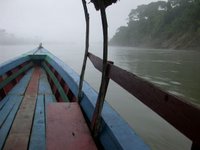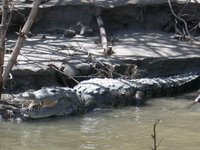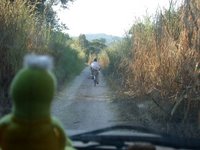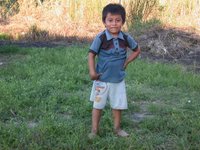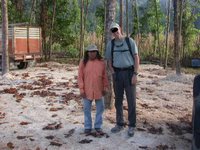My grandfather was a merchant marine who sailed around the world seven times. He also fathered seven children. He was also a drunk. I've often wondered if he had other children in other ports. I'm thinking about him this morning because we are stuck in Chetumal waiting for jeep repairs. We will probably be here a week. Being port bound is part of life for sailors. Many have stayed months or years waiting for ship repairs. Many children were born in the interim. I've always suspected we have an unknown cousin or two somewhere in the world.
When we were buying the tent for the top of our jeep we met a guy named Frenchie La Chance. He had a built up Cherokee like ours and was an off-road adventure guide. On the side he worked with the only guy in the States who imported the tent we wanted. Frenchie´s rig acted as the demo. I was surprised when he told us his last name. Other than my own family, I have never met another Chance. Frenchie actually looked like family, especially his eyes ... too deep, too dark, remotely disturbing. The bone structure of the his face also had the Chance look plus he was nervous, restless, twitchy ... typical Chance mannerisms. So I mentioned, mostly kidding, that perhaps we were related. The mention of his family instantly irritated him. He didn't want to talk about them. He said they were a bad bunch he wanted nothing to do with. That made me wonder all the more if perhaps we actually were related. The Chance family is a bit odd and difficult at times and who knows what adventures and mishaps dear old granddad had on his seven voyages? If Frenchie is a part of our family his aversion may be quite reasonable.
Here´s the thing about us. We call it The Gene. We joke about it but we all know what it means. It´s the Odd Factor, the Frenzy, the corkscrew twist we all share. It makes us interesting but at a price. Then in each generation, it seems one child is the double winner. It was Uncle John in his generation. He thought himself to death. Not a good way to go. I am the "black sheep" in my family but so far, so good. There have been some close calls but It hasn´t gotten me yet. And along the way, I´ve learned to call any day I stay ahead of the bullet a good day. Sweet and simple. Plus I like to think the damn thing ends with me. I have come to believe that it´s entirely possible to be an artist or any other form of creative, conscious individual without self-destructing in the process.
10/11/2005
09/11/2005
Jeep troubles in the Mayan world
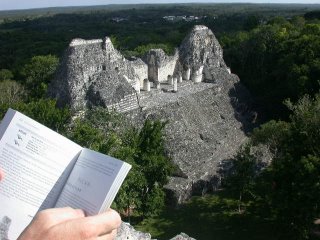 We are back in Chetumal after spending the last week crossing and recrossing the Yucatan peninsula. Jeep troubles. Both front shocks are blown. We drove from Tulum to Chetumal this afternoon to get new ones but found out when we arrived that they don´t carry what we need. We have to have a pair drop-shipped from the US which will take until sometime next week. The road didn´t seem that bad today but as soon as we hit the state of Quintana Roo (keen-tana ((as in Donna))-row) we drove miles of pot holes interspersed with topes (speed bumps). Nothing compared to the grueling trails the jeep crawls in the Nevada's outback but seems it was enough to do some damage. What this means to me tonight is that I have extra computer time. Sick isn´t it? Here we are on a wonderful adventure and Don Jefe has to continually drag me away from the internet cafes. However, inspite of my various pre-existing obsessions I have now also developed a taste for climbing and photographing pyramids, photographing their resident iguanas, huffing the moldy, bat poop and jungle rot air of dank ruins and getting into a melting, dripping, steamy hot, sweaty groove early in the morning. The jungle now haunts my dreams and calls to me when I am away from it. However, to date I have posted way too many pictures of monkeys, graffiti and manikins and almost none of what we came here to do, explore the incredible ruins of the ancient Mayan world so before I go back to the hotel for the night, here´s a few shots from places we´ve visited during the last week. Sorry they aren´t named...perhaps later. They are all in the Yucatan.
We are back in Chetumal after spending the last week crossing and recrossing the Yucatan peninsula. Jeep troubles. Both front shocks are blown. We drove from Tulum to Chetumal this afternoon to get new ones but found out when we arrived that they don´t carry what we need. We have to have a pair drop-shipped from the US which will take until sometime next week. The road didn´t seem that bad today but as soon as we hit the state of Quintana Roo (keen-tana ((as in Donna))-row) we drove miles of pot holes interspersed with topes (speed bumps). Nothing compared to the grueling trails the jeep crawls in the Nevada's outback but seems it was enough to do some damage. What this means to me tonight is that I have extra computer time. Sick isn´t it? Here we are on a wonderful adventure and Don Jefe has to continually drag me away from the internet cafes. However, inspite of my various pre-existing obsessions I have now also developed a taste for climbing and photographing pyramids, photographing their resident iguanas, huffing the moldy, bat poop and jungle rot air of dank ruins and getting into a melting, dripping, steamy hot, sweaty groove early in the morning. The jungle now haunts my dreams and calls to me when I am away from it. However, to date I have posted way too many pictures of monkeys, graffiti and manikins and almost none of what we came here to do, explore the incredible ruins of the ancient Mayan world so before I go back to the hotel for the night, here´s a few shots from places we´ve visited during the last week. Sorry they aren´t named...perhaps later. They are all in the Yucatan.
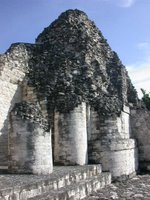



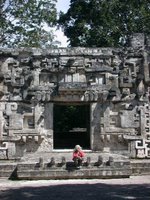
05/11/2005
Biking to Bonampak
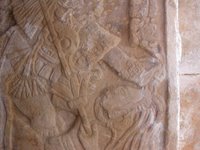
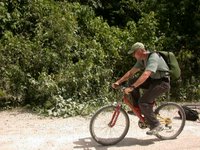
I´ve given up trying to keep up with this trip. So far we´ve put about 7000 miles on the Jeep and I´ve taken over 7000 photos (and deleted about a quarter of them). I know, obsessive-compulsive. Now we are far too far down the road to write or post in chronological order. We´re currently in Merida. To fill in a bit here´s a copy of an email Mr. Lee sent recently about our visit to the ruins at Yaxchilan and Bonampak. Naturally, I have photos to go with this but only have time to post a few at the moment.
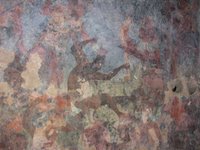

People used to say that the Mayans were completely peaceful but that just isn't so. Murals at Bonampak of ritual mutalation and killing. That's blood dripping from the captive's mutilated hands.
It would be hard for me to describe the past two days without sounding like some dime store adventure pulp, so I won't even try. I can't believe this sort of thing still exists in the 21st century. What follows is just a stream, unedited, typos and misspellings intact, just so I can get it down and then go to bed.
Departing Palenque, we took Hwy 307, a relatively new highway opening Mexico's last frontier, the Lancandon rain forest. It's a shame, really, but I guess humans won't stop until it's all gone. Well, it's not all gone yet.
We drove this road for about 100 miles, passing many tiny farming communities. Given that wood is in good supply and concrete in short supply, the pioneers all build with wood. It looks more like Belize than Mexico, with the exception that there is wave after wave of pioneers. Land that has become too poor to grow corn, beans and squash is burned to promote grass for cattle. Everyone looks fairly prosperous, in a rustic sort of way. As we continued down the new highway, we moved farther and farther back in time and the jungle increasingly pressed in on the road.We reached our destination within a couple hours. Formerly, the road to Frontera Corozal was an all day grind on rutted, pot-holed dirt. This new road will bring quick change, but for now, Frontera Corozal is a sleepy village (sounds cliche, but there's no better way to describe it--it feels more like the Caribbean in pace). These days, Frontera Corozal is the frontier for Mexican eco-tourism. It's a new concept here. The community runs the one lodge. Even though it's a monopoly, it's reasonable, clean and very efficient (although we well never, ever again order the "mojarra frita", a whole fried fish with an eerie piranha-like smile). We stayed in a thatch-roofed cabana with mosquito netting over the bed, nice fan, and tepid water for the shower. The lodge is also the place to book a boat ("lancha") for the hour-long ride down the Rio Usumacinta to Yaxchilan.
We chartered a boat that evening, to set off early in the morning before any potential tour buses. I met the pilot, and he agreed to meet us at 7am the next day. He was five minutes early, and eager to set off. Our boat was typical, a roughly 30 foot open canoe with giant outboard. With only the three of us, we flew over the water. Like the highway (in fact, the Rio Usumacinta has been a very efficient highway itself, for thousands of years), the farther we went, the lusher the forest. After a short time, we left the corn and bean fields behind and found ourselves in basically intact rain forest. We heard howler monkeys and parrots and saw all kinds of water birds.
By 8am, our pilot steered our boat into the mud bank at the foot of Yaxchilan. The mists were just lifting, and it was just getting light. For the next four hours, we were the only people at the site.
There were no guards, no tourists, no people at all. We explored at a leisurely pace, following an excellent guidebook. At one point, standing in the enormous main plaza next to a large stela covered by a giant plastic tarp, I heard what sounded like the start of a tropical downpour. I looked up, and the stream was hitting one spot on the tarp. There was a troupe of howler monkeys just above the tarp, in amongst some spawling tree branches, and they were just waking. Amazingly, the whole troop began to void their bowels at the same time, splatting all over the tarp. We were just far enough away to avoid the overflow.
They continued to stretch and crap for some time. We watched, riveted. They would be one of several different howler monkey troupes we would see that day. The monkeys were in the trees everywhere, the big males making that distinctive roar. What an incredible experience.
Yaxchilan is the rare Mexican preserve that combines actual preservation with lost city adventure and no settlements. Other than the Rio Usumucinta, there is no road to this site. That's the only thing that keeps it so well-protected.
Throughout the day, we visited ruins major and minor and saw the occasional colorful blur, including toucans and parrots. We agreed that this is one of the best things we've ever done.
The ride back was slower since we were going upstream,and our pilot recognized the value of treating people well, so he slowed or stopped for every turtle or crocodile. At one point, this master pilot drifted back quietly to a croc he'd passed (and we hadn't seen, despite our constant focus) and we moved to within 10 feet of the sleeping beastie--I think he was sleeping, because his mouth was wide open. Eventually, he roused and slid languorously into the water and wee moved on. Asha probably took about a thousand pictures.
(Well, not quite a thousand photos but I did get a couple of good close-ups, not with a telephoto lens though. I don't have one. The pilot actually got us this close to the crocodile. It was very cool but we stayed a bit too long and finally the guy slid off into the water to get away from us. We felt bad about it.)
The jeep was packed and ready to go on our return. We hit the road, heading for a campground near Bonampak. There are two Lancandon indian towns here, one more westernized (barely) and one more traditional. Although it was late in the day, I drove to the Bonampak entrance to scope it out for the next day. We were greeted by an old Lancondon man with traditional haircut (long hair, bangs) and western logger garb. On a whim, I asked him if we could camp there, and he checked with some other younger men, and it seemed fine. Time left in the day, we moved on to visit a local site and spread some pesos among the community, our bid to promote forest preservation and eco-tourism.
We took a hike to "las cascadas", one of the most perfect swimmin' holes I've ever seen, complete with sweltering air temps to promote water sporting. Along the way, we passed a tiny undocumented Mayan ruin.
We got back to the Bonampak entrance after closing, but I wasn´t concerned since there wasn't a gate. But all the folks I'd spoken with earlier were gone. In their place was an ancient albino Lancandon man. I don't speak Spanish that well, but it's passable--it was mesmerizing to talk with this man with his thick Maya accent. He spoke Spanish with the most remarkable inflection---I mean, holy shit, a Maya accent, how anachronistic is that? His eyes looked in different directions and his reddish white hair was cut in the traditional Lancondon style, long with bangs. I guess he must have hypnotized me or used some kind of albino shaman trick, because within minutes we were following his grandson to his house, his grandson having just harvested two giant squash from their "milpa" right next to the Bonampak entrance.We parked the jeep in a flat spot and tried to explain to people for whom Spanish is a distant second language that we were going to sleep in the "lancha" on top of our jeep, that we couldn't sleep in a hammock. I don't figure we could have appeared any crazier to these people, but on the other hand, they were looking pretty strange to us, too. The younger generation--there were four generations living here, the albino shaman grandfather the elder at 80--finally grasped that the white thingg on the jeep was a tent, but grandfather never wavered from his position that we were sleeping in our boat.
After some wild comparisons of our culture in Spanish, English and Mayan, the "artesanias" came out, and we were coerced, softly but relentlessly, into purchasing various necklaces and bracelets made out of local seeds. I knew it would happen. We were being ambushed. I bought some stuff, just enough I think.I spent an hour or so talking to grandsons, 20-somethings with some sense that there was a world beyond their own tiny village. Their world was so tiny. There are no schools beyond primary. Everyone works in the field to produce what they eat. There are no jobs. There's very little surplus. With the exception of western clothes and TVs and, amazingly, satellite cable with a hundred or more channels (which every shack had, no matter how humble, leading me to believe that maybe there's a gov't pacification campaign here, since this is still part of the Zapatista zone), these folks had nothing modern, and no possible way to get it or change their lives in any material sense. They all sold trinkets to tourists for folding money, which they wanted for sugar and soap. Again, this sounds like a cliche, but it's the reality as far as I could see.
The grandsons, I believe, had never seen a large map of Mexico, which I happened to have. They knew nothing of their country. They'd never ventured more than 100 miles from where they lived now, for generation after generation after generation. "No dinero", they kept saying, and sure, they were hitting us up hard, and as I say, we bought what we could, what felt comfortable. It got awkward when they invited us for dinner, since we were sure they'd charge in some fashion, and that dinner would be some kind of range chicken or gamey bush meat.
We pretended to be as tired as we really were, and popped the tent, bidding all a very early goodnight. It was just getting dark.
Culture shock would be putting things mildly here. This was more like a cultural nuke. We clammered into our tent, clothes still on, and doused the lights.
We had a very peaceful night. Upon wakening, we hoped that the folks would be working the fields early and we were right. We made a mad dash for the exit, leaving granny a two-pound box of Swiss chocolates and feeling like we'd all hit some kind of cultural snafu, both sides sort of quiet and sheepish.
Who knows what kind of story they're telling now?We reached Bonampak a few minutes later, dirty and a little crazed. We needed to eat. I popped open the back of the Jeep and poured a couple bowls of shredded wheat and raisins, and then I turned around and noticed the small crowd of Lancondones watching the morning's entertainment (us). It felt weird eating in front of these men, so I invited them to join us, distributing the last of our cereal into bowls and pans. One man asked if this is what we ate in America, and I said yes, sure. What is it made of? Wheat, said another, "trigo". I told them it was a different kind of cereal, not like the Mexican cereal since it lacked sugar. They treated it like an exotic dish and everyone ate everything and then washed bowls and spoons and fingers.
We rented decrepit bikes for the 6-mile ride to Bonampak. The site is very tiny, notable for its close alliance to Yaxchilan as a vassal city, and most famously, for its amazing murals. We saw reproductions in Mexico City and elsewhere, but there's no substitute for the actual setting (lost cities, monkeys, parrots, giant butterflies, albino Mayans).
We were filty and exhausted for our ride back to civilization, which, in this case, was Palenque, former hick town, now giant city with the perspective of a couple days in the Lacandon rain forest.
Now I'm going to surf aimlessly for a few minutes and then pester Asha to unplug so we can go to our room and crash. Next stop, Chetumal, sweet blessed funky Chetumal.
L.
Labels:
family,
guest blogger,
Mexico,
photos,
road notes,
travel notes
01/11/2005
Día de los Muertos
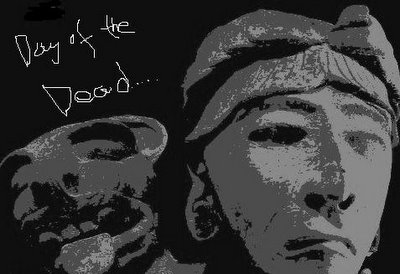
We are now in Compeche,
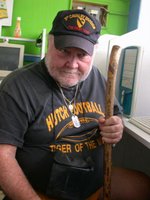 a small port city on the Gulf of Mexico. We didn´t stick around to meet with Dan the other day or try camping at the ruins. Instead we shot across the Yucatan in search of better weather, which we found here.
a small port city on the Gulf of Mexico. We didn´t stick around to meet with Dan the other day or try camping at the ruins. Instead we shot across the Yucatan in search of better weather, which we found here.
Today is Día de los Muertos, Day of the Dead, so in observation of it here are a few photos I´ve taken on the trip that are to me, in one way or another, in the spirit.
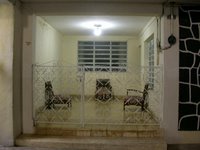
The first is of the waiting room for a funeral parlor. It is right on the sidewalk and cannot be closed off because it has no doors.
The rest have each their own mystery except for the photo from the miscellenia store (variety store) of the skulls on the artificial Christmas tree. That one is simply and delightfully absurd.

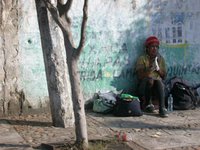

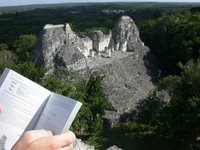
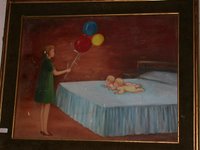
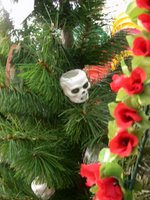
Happy Día de los Muertos and Merry Christmas!
Labels:
Mexico,
photos,
road notes,
travel notes
30/10/2005
Beta news and guaqueque blues
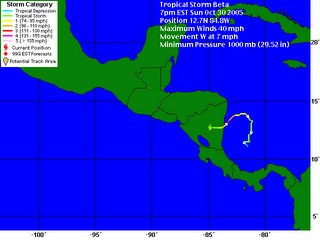
Looks like Hurricane Beta has blown out over Nicaragua. It rained here in Chetumal today but we even missed that being out of the immediate area visiting 3 different Mayan ruins. Unfortunately, I forgot my flash drive at the hotel so no new pictures tonight. I took a lot more today but the most moving thing was coming upon a poor guaqueque (waa-kay-kay) being killed by a small fox. I butted in, scared the fox who tried unsuccessfully to drag the crying guaqueque away with her, and made a mess of the whole thing. Then, while photographing the event, started the guaqueque crying again. Bad scene. The fact is I am on both sides of the struggle. The fox needed the food, maybe even for her family, and the guaqueque want to live. I don´t know how it turned out. We went back later to check up on things but there nothing. Not even one drop of blood. Life is hard. Everyone is food for someone but I want to feed everybody soy and tofu and call it good ...sigh
Tomorrow, depending on the weather, we will either visit more Mayan sites or hang around town. If we stay in Chetumal we´ll meet our new friend Dan at the internet cafe
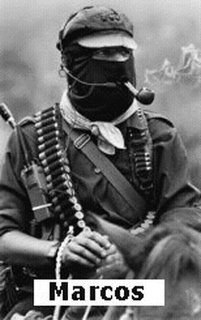 in the afternoon then go hang out on the beach with him. Dan is one of those bigger than life people you sometimes meet on the road. He´s got great stories. He said when he was a young man he was going to play for the Chicago Cubs but then got drafted and fought in Vietnam. Later, among other things, he became a journalist and sailed across the Atlantic solo. He also claimed to have golfed with President Gerald Ford, interviewed Subcomandante Marcos several times. He lost his voice to cancer about five years ago and can´t talk above a whisper. We had lunch with him yesterday. Even without a voice he whispered, gestured and scribbled stories for several hours, waving one or another of his various knives from time to time for emphasis. One of the great things about Mexico is that you can have these kind of animated converstations and nobody objects. The waiters just went about their business. The only thing they worried about was that Dan had left the windows down in his vehicle and there was some expensive looking equipment in the front seat. They ended up guarding it for him because he wasn´t concerned about it being stolen. All this would be impossilbe in the paranoid US.
in the afternoon then go hang out on the beach with him. Dan is one of those bigger than life people you sometimes meet on the road. He´s got great stories. He said when he was a young man he was going to play for the Chicago Cubs but then got drafted and fought in Vietnam. Later, among other things, he became a journalist and sailed across the Atlantic solo. He also claimed to have golfed with President Gerald Ford, interviewed Subcomandante Marcos several times. He lost his voice to cancer about five years ago and can´t talk above a whisper. We had lunch with him yesterday. Even without a voice he whispered, gestured and scribbled stories for several hours, waving one or another of his various knives from time to time for emphasis. One of the great things about Mexico is that you can have these kind of animated converstations and nobody objects. The waiters just went about their business. The only thing they worried about was that Dan had left the windows down in his vehicle and there was some expensive looking equipment in the front seat. They ended up guarding it for him because he wasn´t concerned about it being stolen. All this would be impossilbe in the paranoid US.---------------------
Bruce Hodder of SUFFOLK PUNCH wrote a nice review of this current series on our travels in Mexico. I´m always grateful for a good word. Thanks Bruce!
Labels:
Mexico,
road notes,
travel notes
29/10/2005
Chetumal, any port in the storm
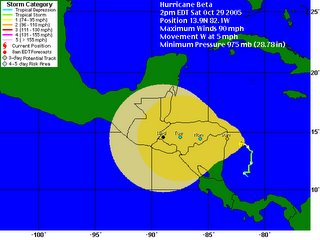 I´ve still got a lot of photos to post from this trip to catch up with myself but am fast forwarding to today. Hurricane Beta is in the region and at the moment has my full attention. This is a map of Beta´s five day forcast. We are currently in the town of Chetumal which is located at about 3 minutes after 12 on the map´s outer circle. This puts us in the outer range of the hurricane´s projected path so once again our plans have changed. We were hoping to camp at Calakmul for a few days so we could explore it to our greedy heart´s content but looks like instead we´ll stay in town for now. Chetuaml is a funky Carribean town on the Belize border, not a bad place to hang your cap in a storm ... I hope.
I´ve still got a lot of photos to post from this trip to catch up with myself but am fast forwarding to today. Hurricane Beta is in the region and at the moment has my full attention. This is a map of Beta´s five day forcast. We are currently in the town of Chetumal which is located at about 3 minutes after 12 on the map´s outer circle. This puts us in the outer range of the hurricane´s projected path so once again our plans have changed. We were hoping to camp at Calakmul for a few days so we could explore it to our greedy heart´s content but looks like instead we´ll stay in town for now. Chetuaml is a funky Carribean town on the Belize border, not a bad place to hang your cap in a storm ... I hope.
Labels:
Mexico
27/10/2005
Monkey games
The photos are running behind the trip. Currently we are back in the town of Paleneque after spending a couple of days on the Guatemalan border visiting Mayan sites. However, I got a big kick out of this sequence from the wild life refuge in Tuxtla Gutierrez so am posting them tonight. They are of a young monkey chasing the vultures out of tops of the trees. There are lots of vultures at the reserve. They are fed like everyone else and have lots of places to roost, but seem to enjoy annoying the monkeys by perching in the tops of the trees in their area. This little fellow made quick work of them. Look closely at photos 7 through 10. You will see glimpses of one of the vultures flying off.


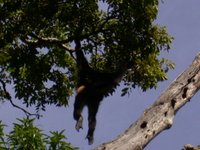


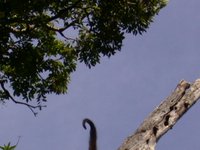
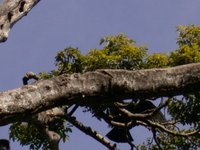


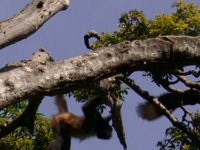
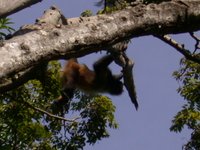

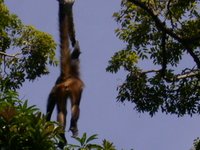

Since this we've seen monkeys and crocodiles in the wild. That was wonderful and just this evening I saw a huge green free parrot sitting casually at the lunch counter of a taco stand but didn't have my camera for that one.














Since this we've seen monkeys and crocodiles in the wild. That was wonderful and just this evening I saw a huge green free parrot sitting casually at the lunch counter of a taco stand but didn't have my camera for that one.
25/10/2005
Monkeys in Mexico
Until this trip, I didn´t realize that monkeys are native to North America. But they are, in Mexico. As usual, I don´t have much time but here are a few photos from our visit to the wild life refuge in Tuxtla Gutiérrez, the capital city of Chiapas.
The monkeys at the refuge seemed to enjoy chasing the vultures off who were hanging out in their trees. Next time I have a chance I´ll post some photos I got of them doing that.
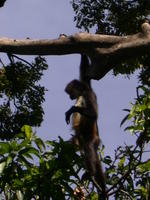



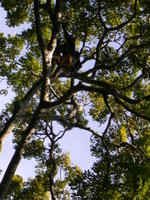
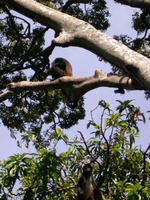
Since then we´ve seen wild monkeys around the Mayan ruins of Palenque but, although they stayed right above our heads, I couldn´t get a decent shot of them. Too dark. Monkeys are cool. Their tails are powerful as giant snakes. It was nothing for them to hang upside down, munch a meal and watch us flat-footed, tailless humans far below.
The monkeys at the refuge seemed to enjoy chasing the vultures off who were hanging out in their trees. Next time I have a chance I´ll post some photos I got of them doing that.




Since then we´ve seen wild monkeys around the Mayan ruins of Palenque but, although they stayed right above our heads, I couldn´t get a decent shot of them. Too dark. Monkeys are cool. Their tails are powerful as giant snakes. It was nothing for them to hang upside down, munch a meal and watch us flat-footed, tailless humans far below.
Labels:
critters,
Mexico,
photos,
road notes,
travel notes
23/10/2005
Oaxaca mannequins and other street scenes
For those very few people who visit this tiny outpost, I´ve added a few more photos, mostly from Oaxaca. I´m behind. We´re in Palenque today. It´s breezy and cool, I suppose side effects from Hurricane Wilma which passed over the not so distant Yucatan. I hope all goes well for everyone as it moves northward. I´m doing this on the fly. I hope it´s not full of typos and bad grammer. As usual, I´m short on time. Hope you enjoy them. More later. Tomorrow we go to Palenque, a small but perhaps finest of the Mayan ruins. a.
__________________________________________________
We stayed at a hostel in Oaxaca rumored to be the former home of Oaxacan painter Rufino Tamayo. I don´t know if it´s true. We stayed in a roof top room, third floor; terrible but cheap. There was an ungodly smell coming from the bathroom. Drinking water was on the second floor but the view was wonderful. We could even see Monte Alban from the roof.

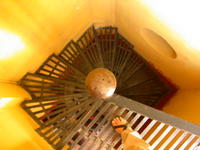
You get used to the presence of machine gun toting soldiers at the pay roads and armed guards walking the streets of every city. They certainly doesn´t make me feel any safer but I can´t resist an occasional sneak shot of them.

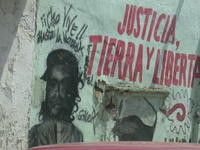
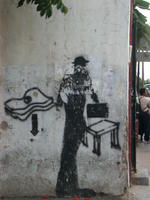

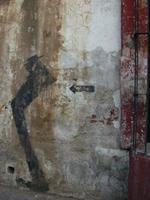
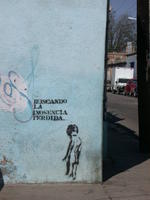


__________________________________________
The mannequins are wonderful in Mexico. Contrary to popular opinion and the Bush administratioin, image is NOT everything. A good foundation is!


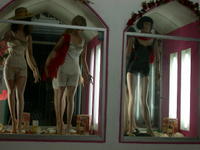


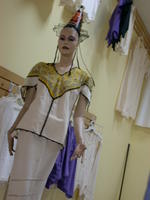
______________________________________________
In Mexico it often takes one man days to do what a machine can do in a few hours. On the other hand, in the US the jails are full of guys who would be working if they weren´t behind bars, sometimes for life, on minor charges or because of the insane Three Strike laws.
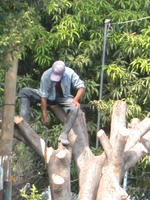
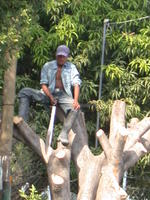
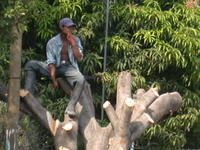
_____________________________________
This girl, her family and two bunnies lived in a tiny hut in the parking lot where we parked the Jeep for the time. The plants are the famous mescal plants. The man and oxen and the poor cows on the way to the slaughter house are familiar roadside scenes.
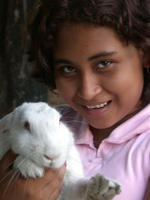



__________________________________________________
We stayed at a hostel in Oaxaca rumored to be the former home of Oaxacan painter Rufino Tamayo. I don´t know if it´s true. We stayed in a roof top room, third floor; terrible but cheap. There was an ungodly smell coming from the bathroom. Drinking water was on the second floor but the view was wonderful. We could even see Monte Alban from the roof.
You get used to the presence of machine gun toting soldiers at the pay roads and armed guards walking the streets of every city. They certainly doesn´t make me feel any safer but I can´t resist an occasional sneak shot of them.






__________________________________________
The mannequins are wonderful in Mexico. Contrary to popular opinion and the Bush administratioin, image is NOT everything. A good foundation is!

______________________________________________
In Mexico it often takes one man days to do what a machine can do in a few hours. On the other hand, in the US the jails are full of guys who would be working if they weren´t behind bars, sometimes for life, on minor charges or because of the insane Three Strike laws.



_____________________________________
This girl, her family and two bunnies lived in a tiny hut in the parking lot where we parked the Jeep for the time. The plants are the famous mescal plants. The man and oxen and the poor cows on the way to the slaughter house are familiar roadside scenes.



Labels:
Mexico,
photos,
road notes,
travel notes
Subscribe to:
Posts (Atom)

